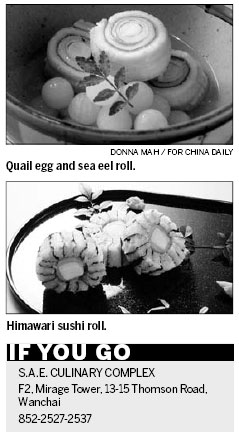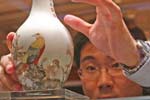Food
Japanese still on the menu
Updated: 2011-04-10 07:55
By Donna Mah (China Daily)
 |
Hong Kong
The popularity of Japanese food in Hong Kong is undisputed. And still is, in spite of radiation scares and health concerns about contaminated seafood.
Japanese restaurants here are also quick to assure diners that their seafood sources are safe. One private kitchen in Wan Chai is sourcing its produce from the United States, Canada, Australia, South Korea and Russia.
S.A.E. Culinary Complex does not sound like it serves Japanese food, but this is exactly what it does. And it does it well. The portions are decent and the prices are very reasonable to boot.
As with most private kitchens in the city, S.A.E. was started by someone who loves food and wanted the freedom to present it on his own terms.
Chef Ma Ki-leung started his culinary adventures in 1976 and has worked at Nadaman in the Island Shangri-la and at Kaetsu in the Grand Hyatt Hong Kong. Both venues are well-known for excellent food, so it is no surprise that S.A.E. delivers the standard.
S.A.E. is on the second floor of a small commercial building along a Wan Chai side street - not a prime location by any means. The dcor is simple, with wood and dark colors. The most brightly lit area is the sushi bar on one side, where the fresh cuts of fish are displayed.
The restaurant allows customers to bring their own alcohol with no corkage charge, or diners can choose something from the drinks menu.
Things have not changed a great deal at S.A.E. over the years. They still serve lunch and dinner sets that provide good value for money. Lunch sets are HK$70 ($9) and include an appetizer, assorted sashimi, miso soup, steamed custard, rice and dessert. There is a long list of mains to choose from including prawn and vegetable tempura, assorted sushi, spicy tuna and scallop on rice, and broiled mackerel.
There are a few credit card-related dinner promotions currently with sets of six to eight courses priced at about HK$200 per person. One of my favorites is the steamed teapot soup with seafood (it comes in a small clay tea pot from which you pour your soup), a generous sashimi platter, and an innovative dessert to end the meal. Desserts include gingko-nut tofu with green-tea ice cream, ginger crme brulee with green-tea ice cream, banana tempura with sesame ice cream, and wasabi mousse with red-bean ice cream.
Chef Ma is currently busy with his consulting work for F&B group, Le Nest. It plans to open 300 Japanese restaurants within four years. The restaurants will be located in about 50 mainland cities.
Specials

Share your China stories!
Foreign readers are invited to share your China stories.

Art auctions
China accounted for 33% of global fine art sales.

Waiting for drivers' seat
Lack of sponsorship appears to be why Chinese drivers have yet to race in a Formula 1 event